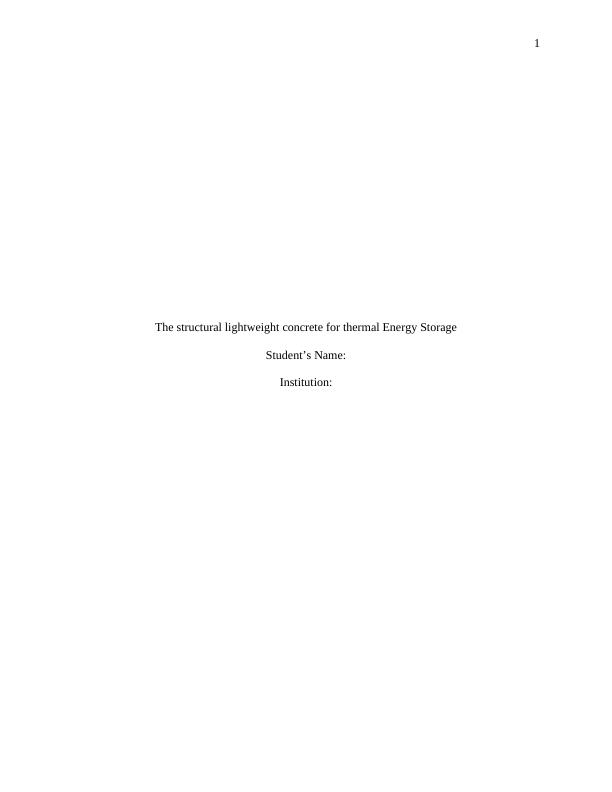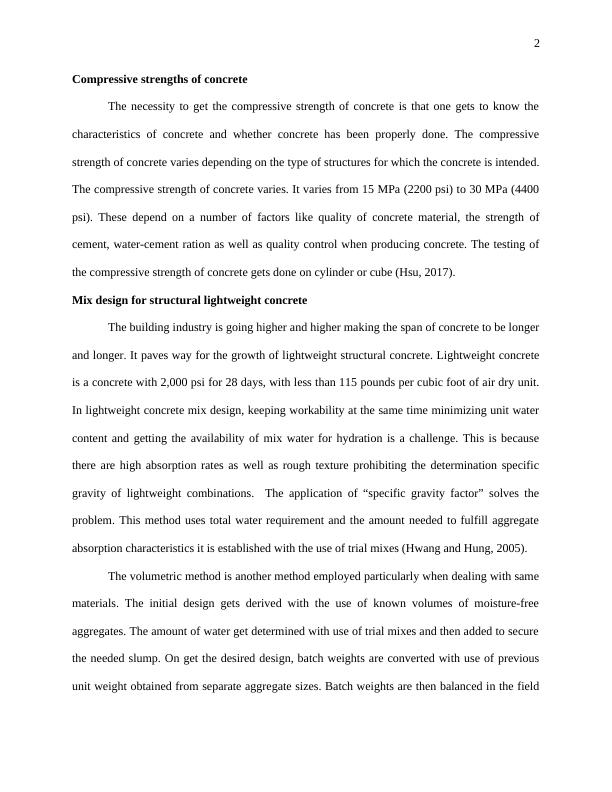Structural Lightweight Concrete for Thermal Energy Storage
Added on 2023-06-14
4 Pages868 Words73 Views
1
The structural lightweight concrete for thermal Energy Storage
Student’s Name:
Institution:
The structural lightweight concrete for thermal Energy Storage
Student’s Name:
Institution:

2
Compressive strengths of concrete
The necessity to get the compressive strength of concrete is that one gets to know the
characteristics of concrete and whether concrete has been properly done. The compressive
strength of concrete varies depending on the type of structures for which the concrete is intended.
The compressive strength of concrete varies. It varies from 15 MPa (2200 psi) to 30 MPa (4400
psi). These depend on a number of factors like quality of concrete material, the strength of
cement, water-cement ration as well as quality control when producing concrete. The testing of
the compressive strength of concrete gets done on cylinder or cube (Hsu, 2017).
Mix design for structural lightweight concrete
The building industry is going higher and higher making the span of concrete to be longer
and longer. It paves way for the growth of lightweight structural concrete. Lightweight concrete
is a concrete with 2,000 psi for 28 days, with less than 115 pounds per cubic foot of air dry unit.
In lightweight concrete mix design, keeping workability at the same time minimizing unit water
content and getting the availability of mix water for hydration is a challenge. This is because
there are high absorption rates as well as rough texture prohibiting the determination specific
gravity of lightweight combinations. The application of “specific gravity factor” solves the
problem. This method uses total water requirement and the amount needed to fulfill aggregate
absorption characteristics it is established with the use of trial mixes (Hwang and Hung, 2005).
The volumetric method is another method employed particularly when dealing with same
materials. The initial design gets derived with the use of known volumes of moisture-free
aggregates. The amount of water get determined with use of trial mixes and then added to secure
the needed slump. On get the desired design, batch weights are converted with use of previous
unit weight obtained from separate aggregate sizes. Batch weights are then balanced in the field
Compressive strengths of concrete
The necessity to get the compressive strength of concrete is that one gets to know the
characteristics of concrete and whether concrete has been properly done. The compressive
strength of concrete varies depending on the type of structures for which the concrete is intended.
The compressive strength of concrete varies. It varies from 15 MPa (2200 psi) to 30 MPa (4400
psi). These depend on a number of factors like quality of concrete material, the strength of
cement, water-cement ration as well as quality control when producing concrete. The testing of
the compressive strength of concrete gets done on cylinder or cube (Hsu, 2017).
Mix design for structural lightweight concrete
The building industry is going higher and higher making the span of concrete to be longer
and longer. It paves way for the growth of lightweight structural concrete. Lightweight concrete
is a concrete with 2,000 psi for 28 days, with less than 115 pounds per cubic foot of air dry unit.
In lightweight concrete mix design, keeping workability at the same time minimizing unit water
content and getting the availability of mix water for hydration is a challenge. This is because
there are high absorption rates as well as rough texture prohibiting the determination specific
gravity of lightweight combinations. The application of “specific gravity factor” solves the
problem. This method uses total water requirement and the amount needed to fulfill aggregate
absorption characteristics it is established with the use of trial mixes (Hwang and Hung, 2005).
The volumetric method is another method employed particularly when dealing with same
materials. The initial design gets derived with the use of known volumes of moisture-free
aggregates. The amount of water get determined with use of trial mixes and then added to secure
the needed slump. On get the desired design, batch weights are converted with use of previous
unit weight obtained from separate aggregate sizes. Batch weights are then balanced in the field

End of preview
Want to access all the pages? Upload your documents or become a member.
Related Documents
Civil Engineering Materials and Design Assignment 2022lg...
|8
|1585
|7
